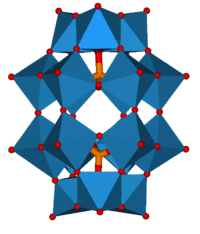Chemistry:Dawson structure
From HandWiki
Short description: Structural motif for heteropoly acids
The Dawson structure is a well-known structural motif for heteropoly acids. The Dawson structure can be viewed as the fusion of two defect Keggin structure, fragments with three missing octahedra. As in Keggin structures, the Dawson structure has an oxyanion at its core. Unlike Keggin structures, there are two such anions, one at each side of the ellipsoidal anion. An example is [S
2W
18O
62]4−, which can also be described as [(SO
4)
2(WO
3)
18]4−.[1]
Commonly, Dawson structures feature phosphate as the central oxyanions. When the Keggin anion [PW
12O
40]3− is allowed to stand in aqueous solution, it converts to [P
2W
18O
62]6−.[2]
References
- ↑ Richardt, Peter J. S.; Gable, Robert W.; Bond, Alan M.; Wedd, Anthony G. (2001). "Synthesis and Redox Characterization of the Polyoxo Anion, γ*-[S2W18O62]4-: A Unique Fast Oxidation Pathway Determines the Characteristic Reversible Electrochemical Behavior of Polyoxometalate Anions in Acidic Media". Inorganic Chemistry 40 (4): 703–709. doi:10.1021/ic000793q. PMID 11225112.
- ↑ Greenwood, Norman N.; Earnshaw, Alan (1997). Chemistry of the Elements (2nd ed.). Butterworth-Heinemann. p. 1016. ISBN 978-0-08-037941-8.
 |


